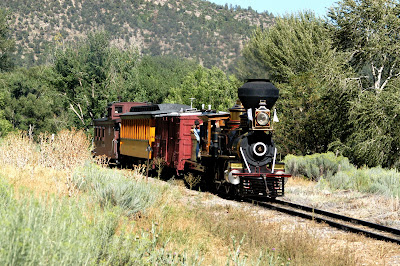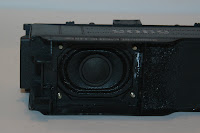Railfest and the Trains of August…
 Every year in August, the Durango & Silverton Narrow Gauge Railroad hosts a celebration of narrow gauge railroading known as True West Railfest. This year allowed some famous pieces of visiting equipment the opportunity to strut their stuff on railfan excursions up the Animas Canyon.
Every year in August, the Durango & Silverton Narrow Gauge Railroad hosts a celebration of narrow gauge railroading known as True West Railfest. This year allowed some famous pieces of visiting equipment the opportunity to strut their stuff on railfan excursions up the Animas Canyon.Visitors included the Eureka and Palisades No. 4, a Baldwin wood-burning 4-4-0 American that has the distinction of being the oldest operating narrow gauge locomotive in the country, the NARCOA club’s line up of historic speeder pop cars, and the RGS historical society's Galloping Goose #5.
 With all of the fun and excitement just a few blocks away George ran down to the depot to make sure he got a chance to see the E&P No. 4 depart. This engine was especially exciting for him to see, as he personally loves locomotives in this wheel arrangement. It's weeks like this when we realize how lucky we are to work only a few blocks from all the action. This makes morning train-chasing trips easy to take in.
With all of the fun and excitement just a few blocks away George ran down to the depot to make sure he got a chance to see the E&P No. 4 depart. This engine was especially exciting for him to see, as he personally loves locomotives in this wheel arrangement. It's weeks like this when we realize how lucky we are to work only a few blocks from all the action. This makes morning train-chasing trips easy to take in.
Another tradition at Railfest is the Presidential Special. This train consists of some of the red first-class cars on the D&S, as well as the General Palmer (the private car of Al Harper, D&S owner). This year's consist was the No. 473 painted with a green boiler (the same green found on our Blackstone Models K-27 No. 455), the newest first-class car called “The Prospector,”“The San Juan,”“The Cinco,” and of course “The Palmer." Two employees here at SoundTraxx were on board the train this year. Jeff played guitar (one many instruments he is skilled at playing) as the onboard entertainment while Jarrette was up in the engine as the fireman.
New SoundTraxx Decoder Selector!
As some of you may have noticed, we have launched our new Decoder Selector on the SoundTraxx website. It includes information for the correct prime mover sound, as well as the Tsunami decoder we recommend for a given model.
We have made it easy to use. First, simply select your scale. It will then pull up a list of popular manufacturers in your scale. After selecting the brand, it will pull up a list of their models that we have sounds available for. The locomotive model will have our suggested decoder and speaker, along with a speaker baffle if available.
Sometimes, there may be more than one option to fit into a model, so we selected one that may require the least amount of work involved. For example, for an HO Athearn Ready To Roll SD40-2, we recommend replacing their ‘DCC quick-plug’ board with our TSU-AT1000 for EMD 645 Turbo (2nd Generation). This board already has the circuitry to regulate the outputs for use with the 1.5V bulbs, which allows more room for the speaker and any wires needed to fit with ease. You could also install a TSU-1000, but we believe the TSU-AT1000 is a better option.
We have made it easy to use. First, simply select your scale. It will then pull up a list of popular manufacturers in your scale. After selecting the brand, it will pull up a list of their models that we have sounds available for. The locomotive model will have our suggested decoder and speaker, along with a speaker baffle if available.
Sometimes, there may be more than one option to fit into a model, so we selected one that may require the least amount of work involved. For example, for an HO Athearn Ready To Roll SD40-2, we recommend replacing their ‘DCC quick-plug’ board with our TSU-AT1000 for EMD 645 Turbo (2nd Generation). This board already has the circuitry to regulate the outputs for use with the 1.5V bulbs, which allows more room for the speaker and any wires needed to fit with ease. You could also install a TSU-1000, but we believe the TSU-AT1000 is a better option.
This is only Phase 1 of our Decoder Selector. For Phase 2, we plan on having additional information available in a step-by-step "application note" (as a PDF document) to help you install the decoders into your model. This may take more time to get done. This is where you may be able to help. If you have installed a Tsunami decoder and speaker in a model listed in our Decoder Selector, you can submit your photos along with a brief description of the installation. If you feel that you have an installation that would be beneficial to other SoundTraxx users, please send an e-mail to georgeb@soundtraxx.com and give a brief description of any methods that you employed to make the installation. Don’t forget to attach the photos to the e-mail. Not all submissions will make it to the final application notes for the website. We would prefer an easy install, but we also want it to be well-planned with proven and reliable techniques that any modeler may be able to accomplish with common tools available to most modelers. For example, be sure the installation can be accomplished using normal hand tools in addition to those with access to a milling machine. We are looking forward to receiving your submissions.
Tech Tip: Getting the Most Out of Tsunami Motor Control Features
In many cases, so many people focus on the great 16-bit digital sound found in the different Tsunami decoders we currently offer that they may not pay as close attention to some of its other great features. On top of being a great-sounding decoder, Tsunami also has some of the best motor control currently found on the market to date.
While many decoders offer 14, 28, and 128 speed step modes (Tsunami being no exception), the Tsunami has 2048 speed steps internally that gives ultra fine speed control. Tsunami is also equipped with back-EMF, which measures the efficiency of the motor and compensates for efficiency losses that happen when under greater loads. This allows your locomotive to have its own "cruise control," meaning that as it starts up a hill or crests down a grade, the train’s speed will stay unchanged as the back-EMF corrects for any changes in the load on the motor. Although this feature is becoming more common in DCC decoders, the great thing about it in Tsunami is that it is completely adjustable.
While many decoders offer 14, 28, and 128 speed step modes (Tsunami being no exception), the Tsunami has 2048 speed steps internally that gives ultra fine speed control. Tsunami is also equipped with back-EMF, which measures the efficiency of the motor and compensates for efficiency losses that happen when under greater loads. This allows your locomotive to have its own "cruise control," meaning that as it starts up a hill or crests down a grade, the train’s speed will stay unchanged as the back-EMF corrects for any changes in the load on the motor. Although this feature is becoming more common in DCC decoders, the great thing about it in Tsunami is that it is completely adjustable.
When adjusting the motor control and back-EMF, there are several different CVs to adjust, however, the first thing to take into account is what type of locomotive you have. Steam engines by nature are a lot less free-rolling than diesel locomotives currently offered. This is due to the fact that diesel models have large flywheels that spin freely. In this example, let's set up an Athearn Genesis SD60M equipped with a TSU-GN1000 to ideal motor control settings. We personally like to slow the locomotive down out of the box, but not to the point that it isn’t realistic. In this example: set CV 209 to a value of 29, CV 210 to a value of 18, and CV 212 to a value of 80 (although the lower you go in this CV, the slower the locomotive will run). CV 209 is known as the Kp Coefficient and is used for adjusting the gain factor for the PID motor control equation. CV 210 adjusts the gain factor of the Ki coefficient for the PID motor control equation. CV 212 adjusts the motor intensity. If you set these values too high, the motor will run very rough. Also, if you set the values to 0, then the motor will stop. When adjusting these CVs, start with 209 and 210 at very low values and increase them each by 1-2 until the model runs smoother. If it begins to run rough, lower the value back down. Once you find the motor running smooth, decrease the value in CV 212 by 10s until it gets you to the slow speed you desire in speed step 1. Also, when using a back-EMF decoder with advanced motor control, make sure to leave CV 2 at a value of 0. Add in a bit of momentum, and your train will start up smooth as silk.
Taking time to adjust the speed control CVs of the Tsunami decoder will produce an excellent running model. Following this procedure, you can have an entire fleet of great-running locomotives and be the envy of all your modeling friends!














